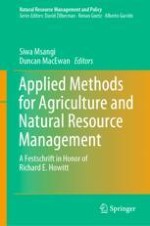2019 | OriginalPaper | Chapter
2. Towards Econometric Mathematical Programming for Policy Analysis
Author : Bruno Henry de Frahan
Published in: Applied Methods for Agriculture and Natural Resource Management
Publisher: Springer International Publishing
Activate our intelligent search to find suitable subject content or patents.
Select sections of text to find matching patents with Artificial Intelligence. powered by
Select sections of text to find additional relevant content using AI-assisted search. powered by
